For many centuries, the pin-tumbler’s technology was forgotten or ignored by European locksmiths who’s will improve the roman warded lock’s construction until the late of the 18th century.
Pendant de nombreux siècles, la technologie des goupilles a été oublié ou tout simplement ignoré du serrurier Européen qui améliorera la construction de la serrure à garnitures d’origine Romaine jusqu’à la fin du 18ème siècle.
Stansbury’s lock
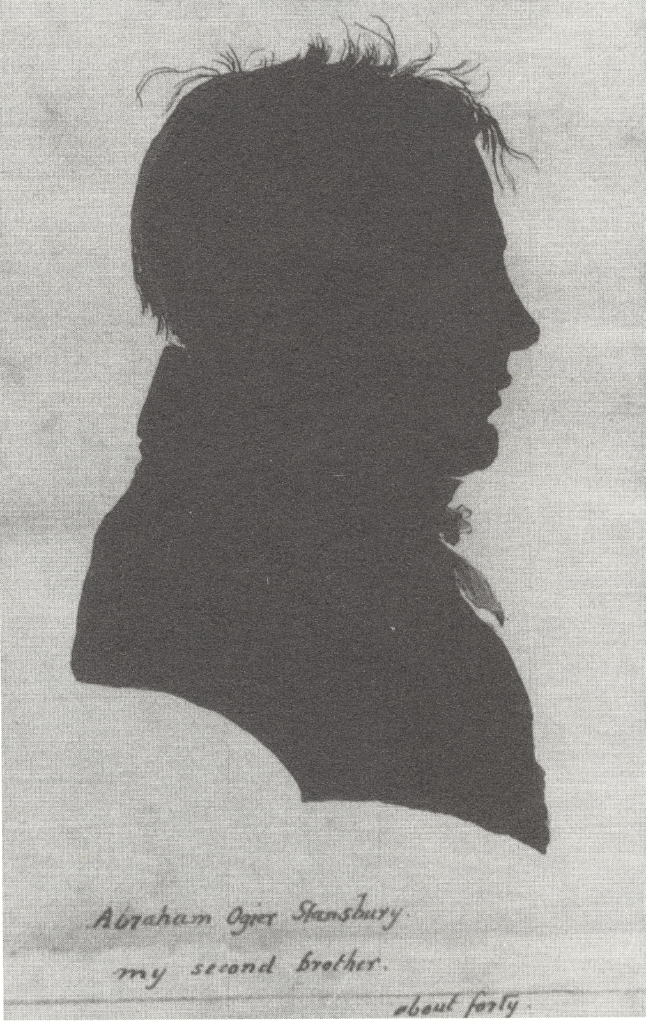
Abraham Ogier Stansbury was an American merchant, publisher, teacher and inventor, born in 1776 in Philadelphia. In 1804, he goes to London to find his sister who stayed there and he will live near Piccadilly Circus until his departure in 1807 [1]. In 1805, he filed a patent for “an Egyptian lock” in wich he will mention the use of the first segmented-pin tumbler’s design. (UK patent N°2851)
Abraham Ogier Stansbury était un marchand, éditeur, enseignant et inventeur Américain, né en 1776 à Philadelphie. En 1804, il part à Londres où il rejoint sa sœur et il vivra près de Piccadilly Circus jusqu’à son départ en 1807 [1]. En 1805, il déposa un brevet pour une “serrure Égyptienne” dans lequel il mentionnera l’utilisation de paire de goupilles. (Brevet anglais N°2851)
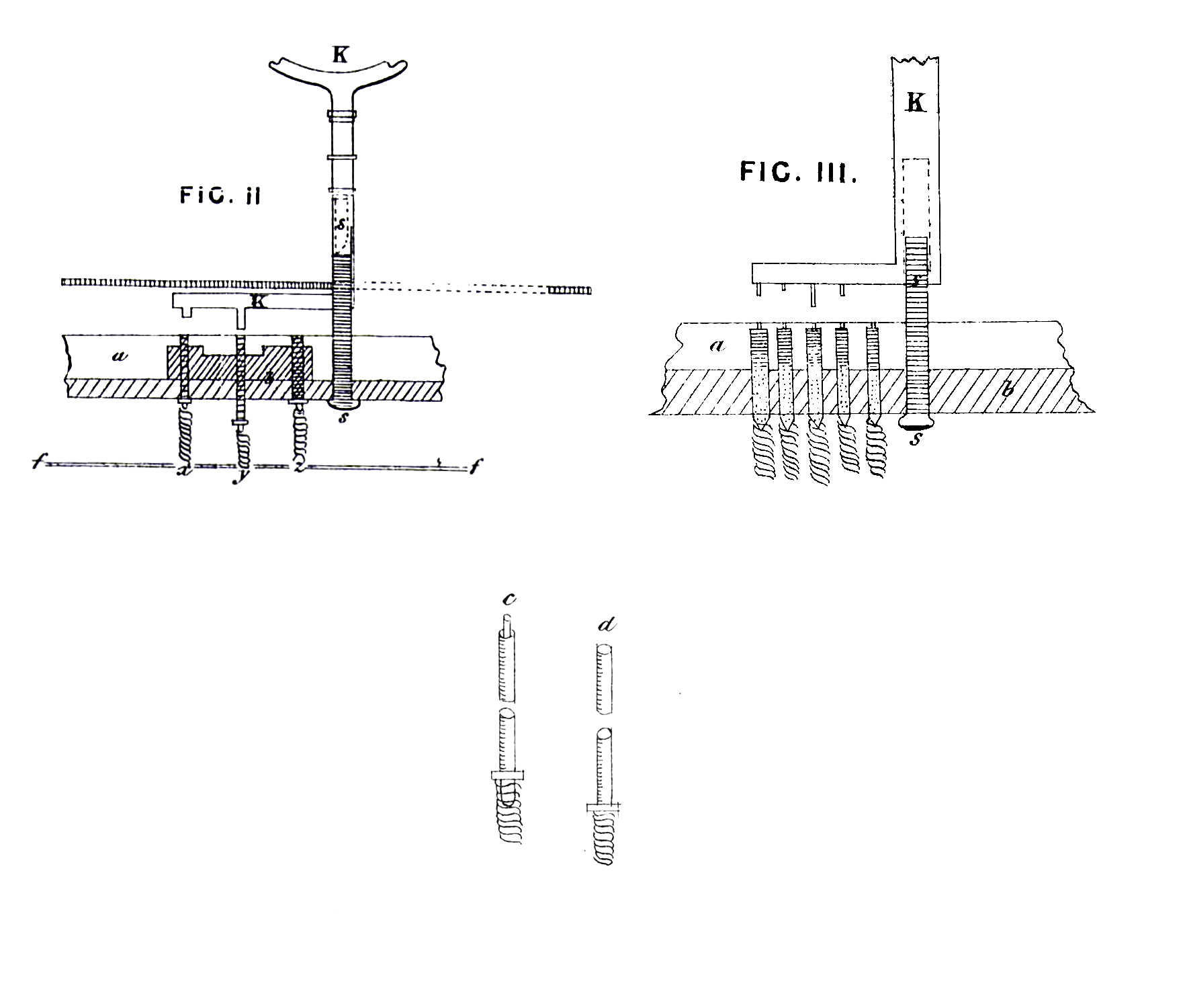
The principle is very simple and it is inspired from the early pin tumbler lock’s design that we have talked in a previous article. The main improvement in the Stansbury’s patent is the use of a segmented pin tumbler sprinloaded with an helicoidal compression spring (or coil spring) used in watchmaking.
Le principe est très simple et il est inspiré des anciennes serrures à chevilles dont nous avons parlé dans un précédent article. La principale amélioration du brevet de Stansbury est l’utilisation d’une paire de goupilles couplées à un petit ressort hélicoïdal de rappel utilisé en horlogerie.

The Stanbury’s lock contains a bolt which can be locked and unlocked with a rotor composed of a box and a revolving plate mounted around a drill-pin. This little box, screwed on the backside of the lock, contains small pins and their flat springs riveted on it. When the bolt is in locked position, all pins protude out of the box, fall in holes made on the revolving plate and block its rotation.
Stansbury’s key have some prongs at the end of its bit. The key is inserted, rotated of some degrees and pushed which allows to compress all pinsout of the plate. The revolving plate now free to turn. A pin fixed on the plate slide in a groove made on the bolt and allows to move it by the plate’s rotation.
La serrure de Stansbury est composée d’un pêne dormant qui peut être verrouillé et déverrouillé par l’intermédiaire d’un rotor composée d’un boitier et de sa plaque tournante montée concentriquement à une broche. Ce petit boitier, vissé au palâtre de la serrure, contient des petites goupilles et leurs ressorts plats rivetés dessus. Quand le pêne est verrouillé, toutes les goupilles dépassent hors du boitier, tombent dans des trous pratiqués dans la plaque et ainsi bloque sa rotation.
La clef de Stansbury possède des tiges au bout de son panneton. La clef est insérée, tournée de quelques degrés et poussée, afin de compresser toutes les goupilles en dehors de la plaque. La plaque est maintenant libre de tourner. Une goupille fixée à l’arrière de la plaque, glisse dans une rainure pratiquée dans le pêne et permet de le mouvoir par la rotation de la plaque.
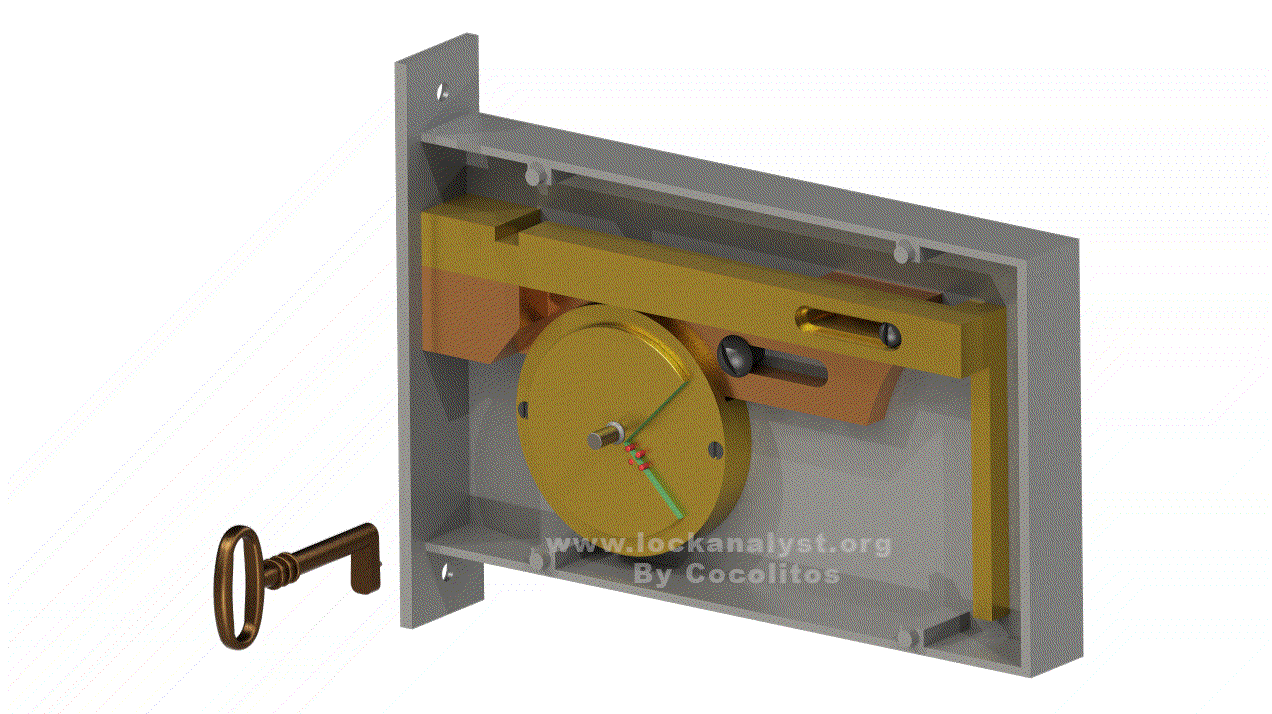
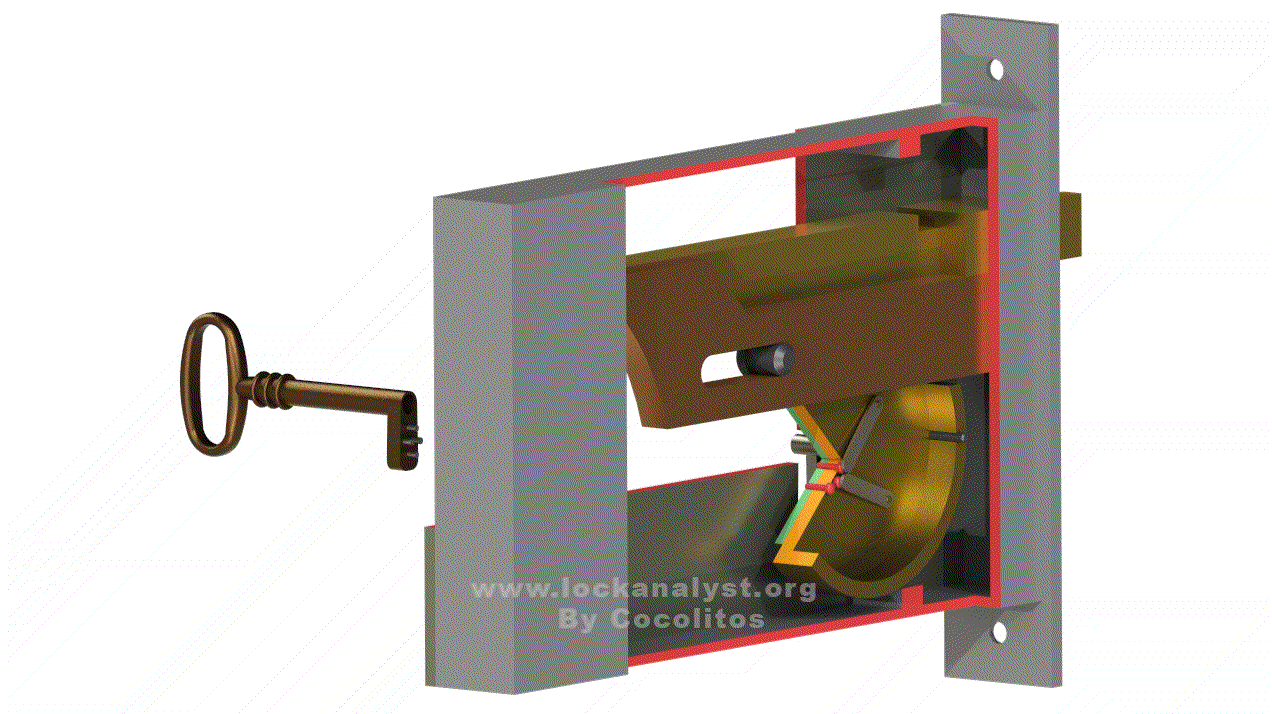
During the year of 1806, Stansbury found some iron-mongers who will produce his lock under license [6]. This ingenious mechanism will arouse admiration of the English because it can be adapted on most common locks in England [1] but Stansbury’s lock will not sell well.
In 1807, Stansbury returned to America and received a patent for the same lock’s design (US patent X727). Unfortunately, his patent burned in the fire of the US patent office in 1836, the only evidence of its existence is a repertory of patent published before this period. We will never know if Stansbury has improved his first English patent of 1805, but we can find a small view of his US patent [2].
Au cours de l’année 1806, Stansbury trouva quelques ferronniers qui produiront sa serrure sous licence [6]. Cette ingénieux mécanisme suscitera l’admiration des Anglais car il peut s’adapter aux serrures les plus courantes d’Angleterre [1], mais sa commercialisation se soldera par un échec.
En 1807, Stansbury retourne aux États-Unis et dépose un brevet pour sa serrure (Brevet américain X727). Malheureusement, son brevet brula dans l’incendie du bureau des brevets Américains en 1836, la seule preuve de son existence est visible dans un répertoire des brevets publié avant cette période. On ne saura jamais si Stansbury avait amélioré son premier brevet de 1805, mais on peut trouver un bref aperçu du brevet américain de 1807 [2].
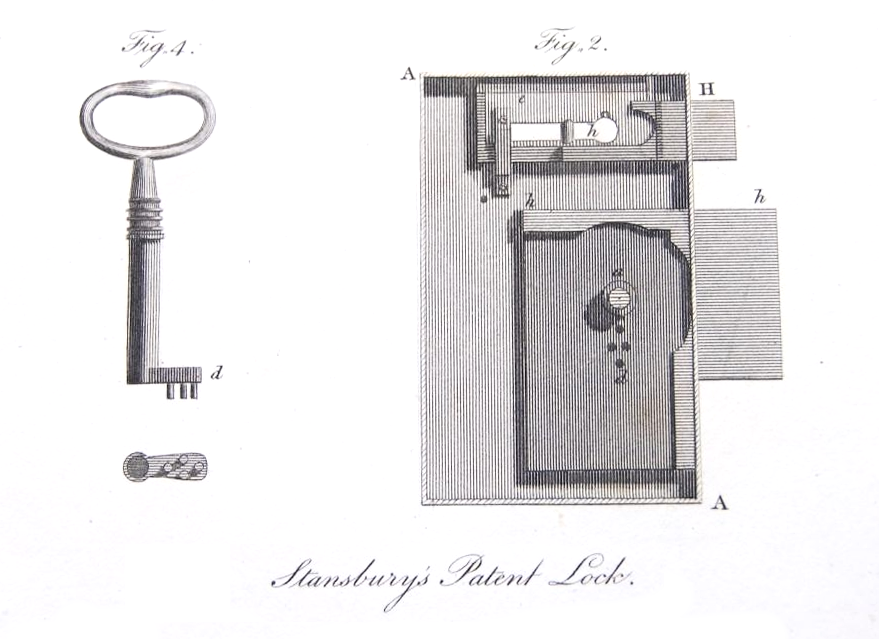
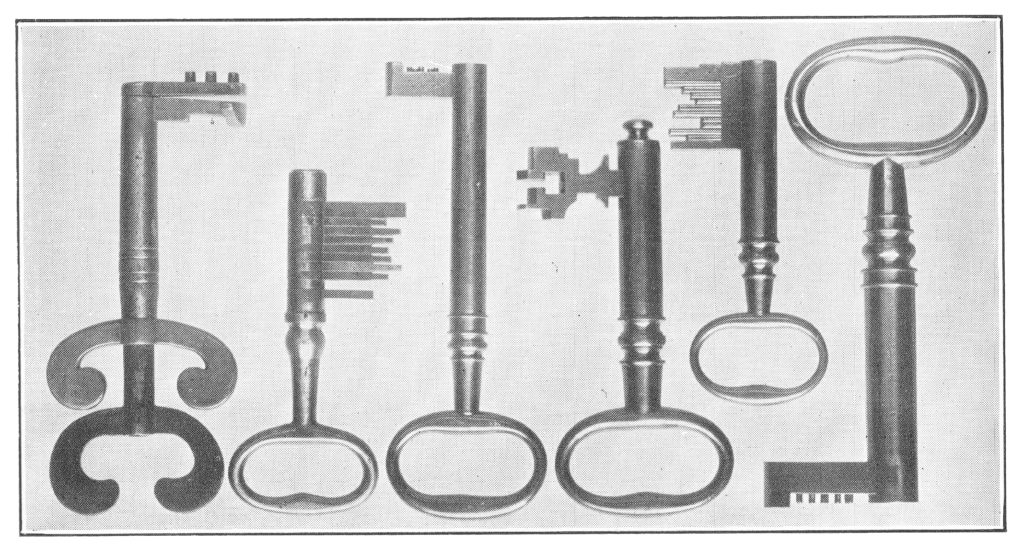
In about 1815, Stansbury sell the right of his patent to William Pye, an American locksmith based in New York who will produce a padlock using Stansbury’s design. In 1819, Mr Pye will accept to pay 200$ if an renewal of stansbury’s patent should be obtained at the end of its validity in 1821 [1], but no patent reissue will be done.
Au environ de 1815, Stansbury vend les droits d’utilisation de son brevet à William Pye, un serrurier Américain de New York qui produira un cadenas utilisant cette nouvelle technologie. En 1819, Mr Pye acceptera de payer 200$ si un renouvellement du brevet devait être obtenu d’ici la fin de sa validité en 1821 [1], mais aucune demande de renouvellement ne fut faite.
Yale’s lock
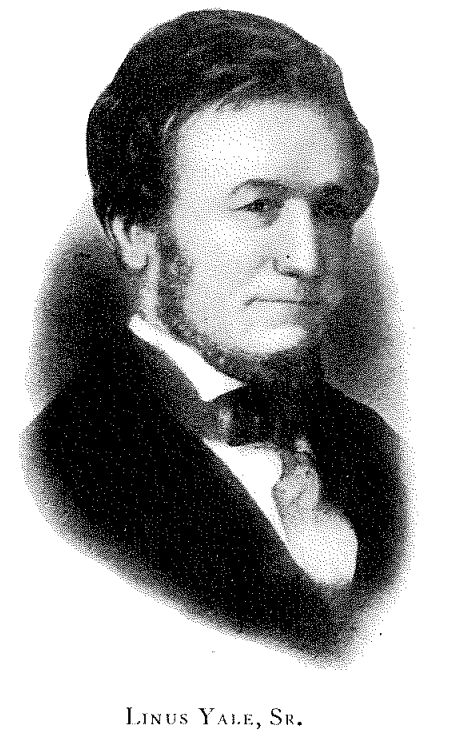
Linus Yale Sr. was an ingenious american inventor, born in 1797 in Middletown, connecticut. He was a excellent mechanic and had a young creative mind. In 1815, he was married to Chlotilda Hopson from Salisbury, New York. They will have three children, Elvira, Chlotilda and Linus Jr. Between 1833 and 1838, Mr Yale will receive some patents, three for a threshing machine, two for an improved saw-mill and one for a process to dress mill stones. In 1840, he moved to Springfield, Massachussetts to learn the art of lockmaking [3].
Linus Yale Sr. était un ingénieux inventeur américain, né en 1797 à Middletown (Connecticut). Il était un excellent mécanicien et avait un vif esprit créatif. En 1815, Il épousa Chlotilda Hopson de Salisbury (banlieue de New York). Ils auront trois enfants, Elvira, Chlotilda et Linus Junior. Entre 1833 et 1838, Mr Yale obtiendra plusieurs brevets, trois pour une machine agricole à battre le grain, deux autres pour une scie à bois améliorée et un pour un procédé permettant l’affûtage des meules. En 1840, Il partit sur Springfield dans le Massachussets pour apprendre l’art de la serrurerie.
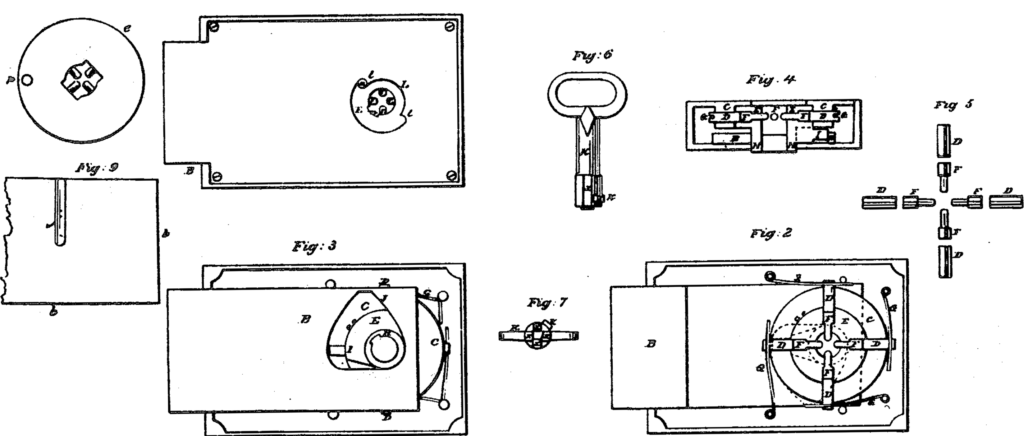
In 1844, Yale received a patent for a door lock (US patent N°3,630) using four rows of two segmented-pin tumblers. The key have a round section with four grooves (or flutes) on which the pins slide when the key is inserted or withdrawed. The first pin-tumbler lock was born with a plug, a shell and some pins radially arranged.
En 1844, Yale dépose un brevet pour une serrure de porte (Brevet américain N°3,630) utilisant quatre rangées de deux paires de goupilles. La clef possède un profil rond avec quatre rainures dans lesquels glissent les goupilles quand la clef est insérée ou retirée. La première serrure à goupilles était née, composée d’un rotor, d’un stator et de goupilles brisées, disposées radialement.
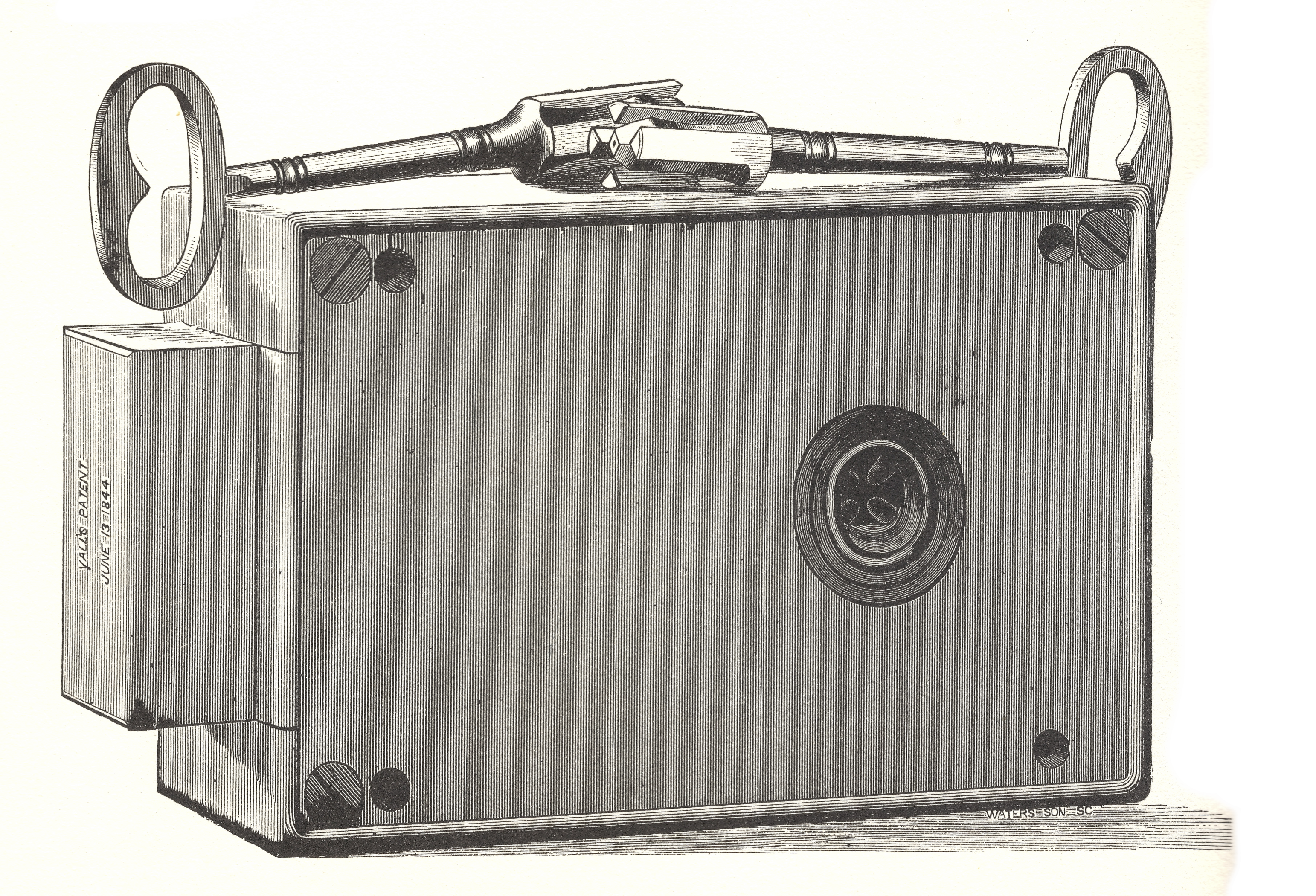
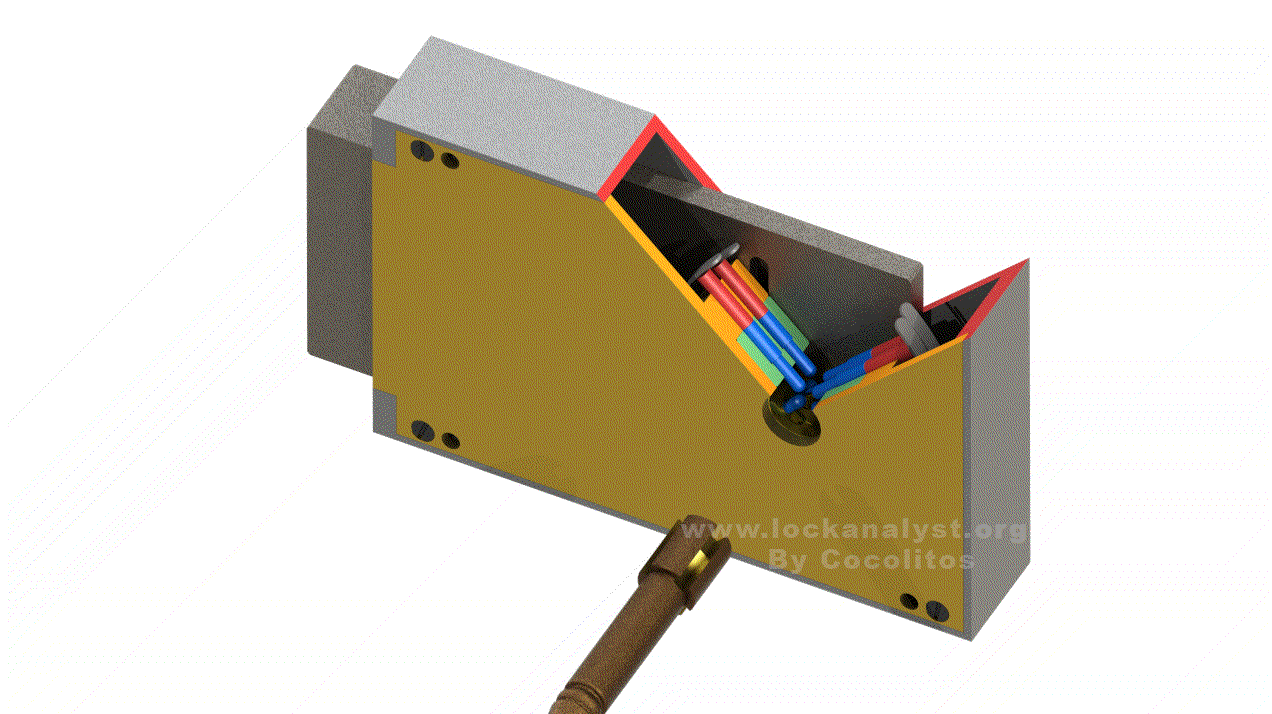
Linus Yale Sr. has obtained some awards for his quadruplex’s lock, but never in his own name. In 1845, he send his son-in-law, Ira L. Cady, who had married his daughter Chlotilda in 1839 [4] and will obtains a premium for his “Yale’s patent lock” at the New York State Fair, Utica [5]. In 1847, he moved to Newport and open his lock shop specializing in expensive handmade bank locks. The same year, he receive a silver medal for a bank lock deposited by Mr Cady at the Fifth Exhibition of the Massachusetts Charitable Mechanic Association [6]. The committee will conclude that Yale’s lock is “safer from picking, gun-cotton and powder than any other known to them”.
Between 1847 and 1849, the quadruplex lock will be produced with a single cylinder which the key had to be oriented correctly, then inserted into the lock. For this, a small cross was made between two grooves as a foolproof. In 1849, Mr Yale obtains a patent for a “lock and latch” with some improvements to his original lock patent (US patent N°6,111). The lock contains two cylinders using four rows of five segmented-pins which will increase the number of combinations. To open this lock, we need two keys, the first is inserted on the right and will authorize the opening of the second lock, on the left. The same year, his son, Linus Yale Jr, joined to his father’s lock shop.
Linus Yale Sr. a obtenu plusieurs récompenses pour sa serrure Quadruplex, mais jamais en son nom propre. En 1845, il envoya son gendre, Ira L. Cady, qui a épousé sa fille ainée Chlotilda en 1839 [4] et obtiendra un prix pour sa “Yale’s patent lock” à l’exposition the New York State Fair à Utica [5]. En 1847, il s’installe à Newport et ouvre sa boutique où il fabriquera des serrures de coffre entièrement faites à la main. La même année, il reçoit une médaille d’argent pour une serrure de coffre remise par Mr Cady aux comités de la Fifth Exhibition of the Massachusetts Charitable Mechanic Association [6]. Le jury concluera que la serrure de Yale est plus sécurisée contre le crochetage, la dynamite et la poudre noire que toutes autres à leur connaissance”.
Entre 1847 et 1849, la serrure quadruplex sera produite avec un seul cylindre dont la clef devait être orientée correctement, puis introduite dans la serrure. Pour ce faire, une petite croix était pratiquée entre deux rainures et servait de détrompeur. En 1849, Mr Yale obtient un brevet pour une serrure avec plusieurs améliorations de la serrure quadruplex (Brevet américain N°6,111). La serrure est constituée de deux cylindres utilisant quatre rangées de cinq paires de goupilles permettant d’augmenter la puissance combinatoire. Pour ouvrir cette serrure, on a besoin de deux clefs, la première est insérée à droite et autorisera l’ouverture de la seconde serrure (à gauche). La même année, son fils, Linus Yale Jr, le rejoint dans la boutique familiale.
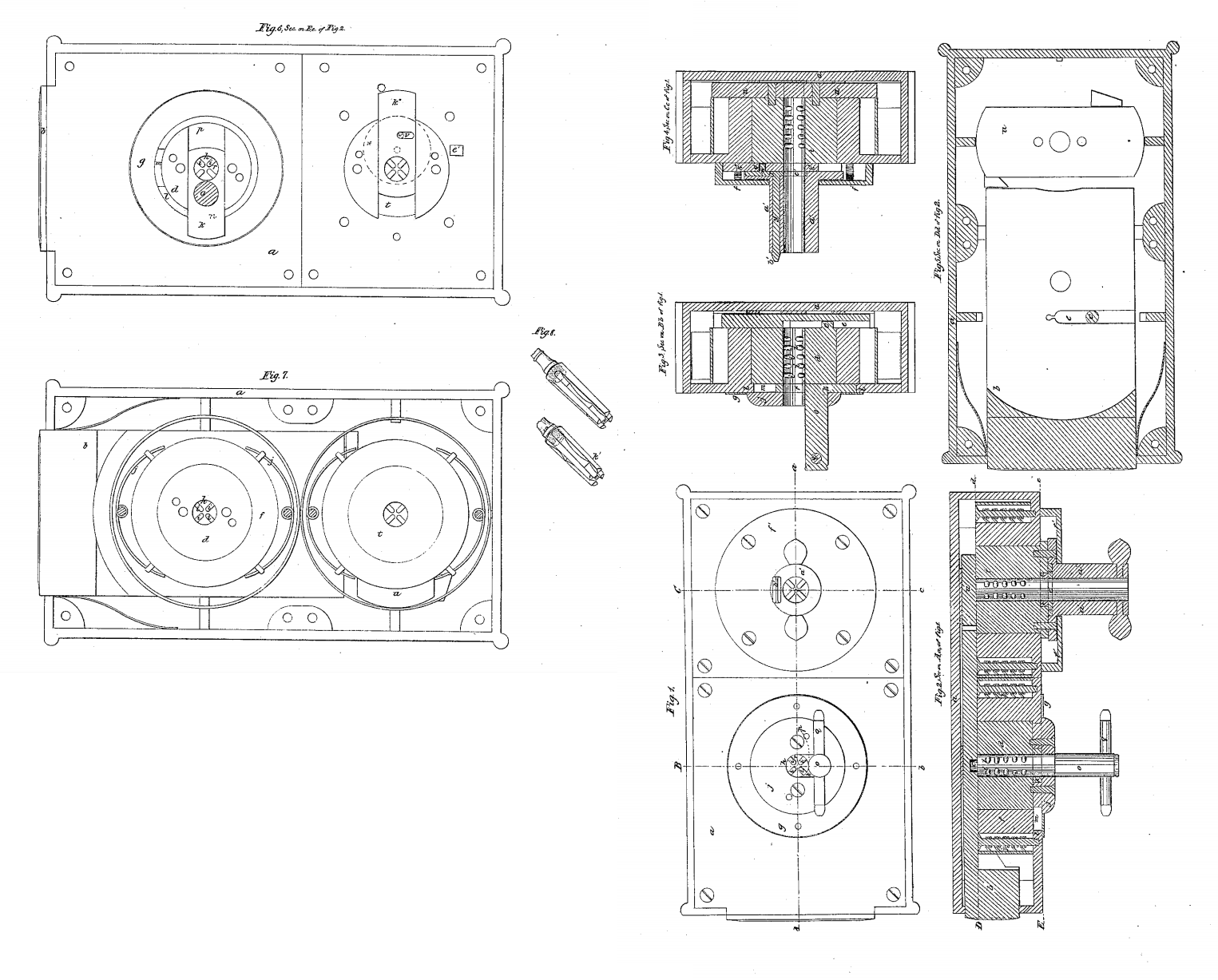
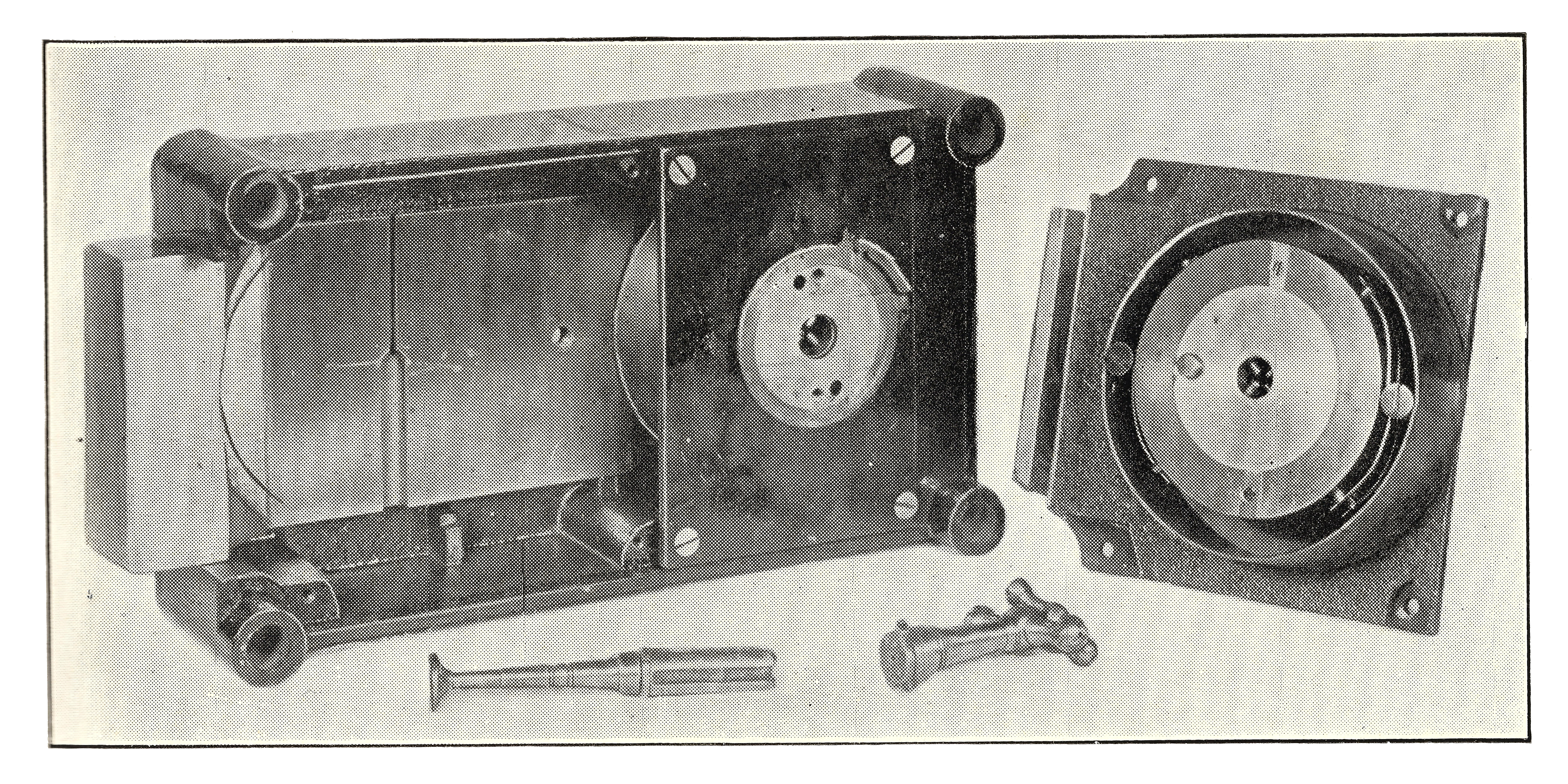
In 1850, Nathaniel Bacon, a lock manufacturer from Springfield, will produce the Quadruplex’s lock and pay the right to use the Yale’s patent [7]. In 1852, Linus Yale Sr. sold his original patent to Nathaniel Bacon’s son, Steuben T. Bacon [8] and the Yale Quadruplex’s lock will be known as the Bacon’s lock.
En 1850, Nathaniel Bacon, un fabricant de serrure de Springfield, produira la serrure Quadruplex et payera les droits d’utilsation du brevet à Linus Yale [7]. En 1852, Linus Yale Sr. vend son brevet original au fils de Nathaniel Bacon, Steuben T. Bacon et la serrure Quadruplex sera connu dans tout le pays comme la serrure de Mr Bacon.
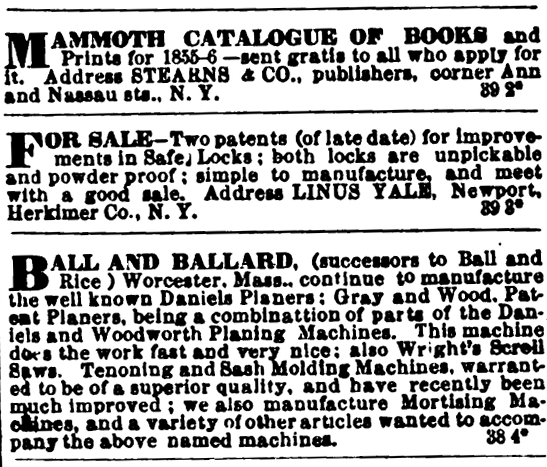
Linus Yale Jr. will be very annoyed by his father’s attitude of wanting to resell these patents and especially that he does not want to produce them himself. In 1855, he moved to philadelphia and began his own business and will try to distinguish his father’s business from his new notoriety acquired between 1851 and 1855 by the picking of the parautoptic’s lock recognized as one of the most secure in the world [10].
Linus Yale Jr. sera très agacé par l’attitude de son père de vouloir revendre ces brevets et surtout de ne pas vouloir les produire lui-même. En 1855, il s’installe à Philadelphie, démarre son propre entreprise et tentera de distinguer les affaires de son père de sa nouvelle notoriété acquise entre 1851 et 1855 par le crochetage de la serrure Parautoptic reconnue comme l’une des plus sécurisées au monde [10].
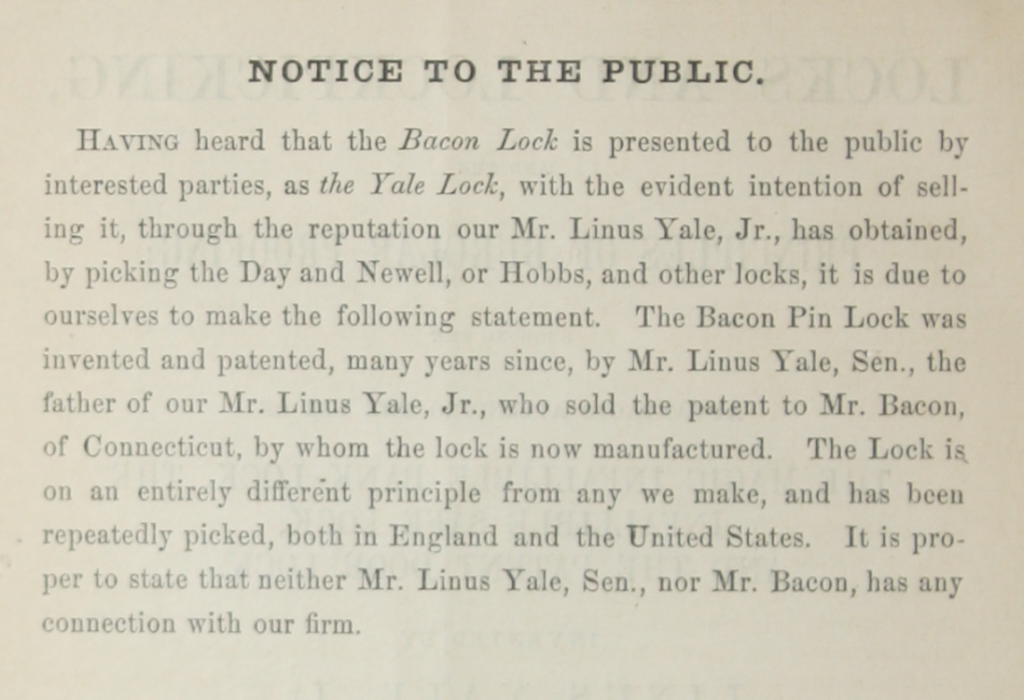
During 1852 to 1860, Mr Bacon will produce the first version of the Quadruplex’s lock and receive two patents to improve it in 1859 (US patent N°24,709) with the first anti-picking device : the serrated pin.
De 1852 à 1860, Mr Bacon produira le première version de la Yale Quadruplex et déposera deux brevets afin de l’améliorer en 1859 (Brevet américain N°24,709) avec le premier système anti-crochetage : la goupille crantée.
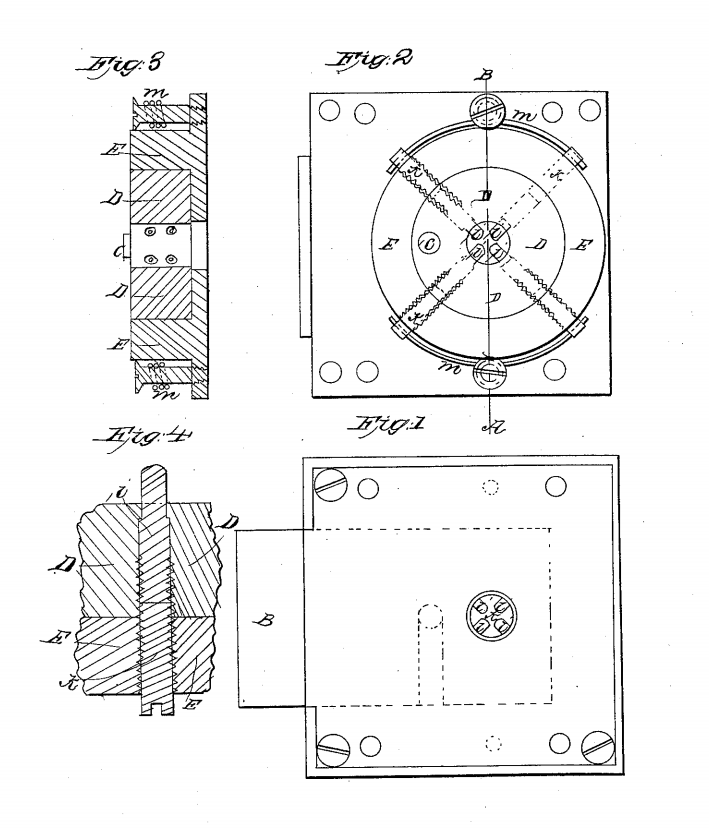
In 1857, Linus Yale Sr. received a patent for a sliding padlock using five pin-tumblers inline and a round fluted key (US patent N°18,169). This padlock is an improved Egyptian lock but its construction remains similar to padlocks that are manufactured today. Notice the use of coil springs which can be manufactured with a machine patented the same year [9].
En 1857, Linus Yale Sr. déposa un brevet pour un cadenas à glissière utilisant cinq goupilles en ligne et une clef ronde rainurée (Brevet américain N°18,169). Ce cadenas est une amélioration de la serrure égyptienne mais sa construction reste similaire aux cadenas produits de nos jours. Notez l’utilisation de ressorts hélicoïdaux de compression qui ont pu être fabriqué par une machine brevetée la même année [9].
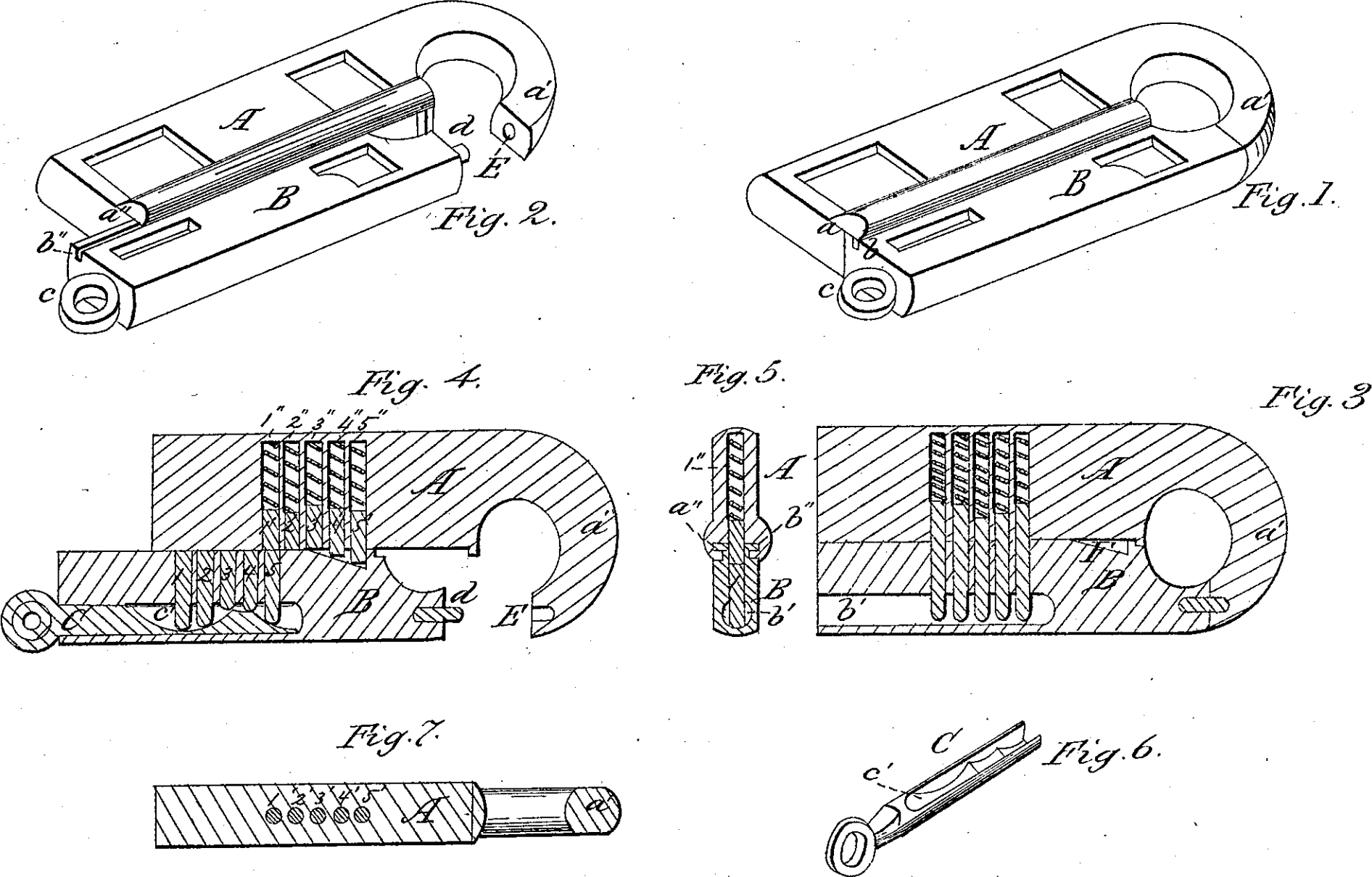
The main parts of this padlock are made by bronze casting and finished with handmade polishing process. After, holes are drilled in the bible. This step requires no special jigs or tools because all part have two flated surfaces allowing them to be clamped easily in a vice. Finally, the sliding part are adjusted correctly and assembled by a pin.
Les pièces principales du cadenas sont fabriquées en bronze par moulage et finis par un procédé de polissage à la main. Après, des trous sont percés dans la pièce non-coulissante. Cette étape ne requiert aucun gabarits ou outillages spéciaux car toutes les pièces possèdent deux surfaces planes permettant de les brider facilement dans un étau. Enfin, la glissière est ajustée correctement et assemblée par une goupille.
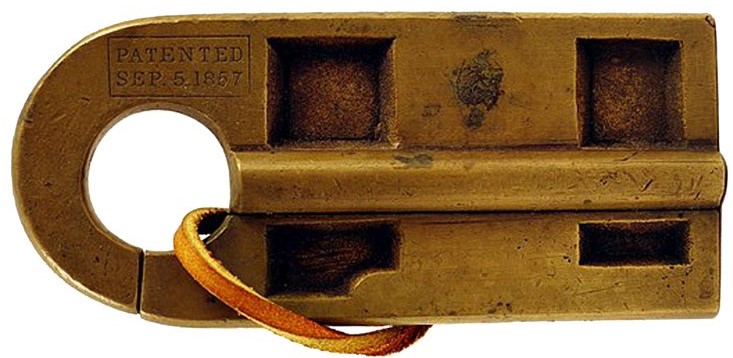
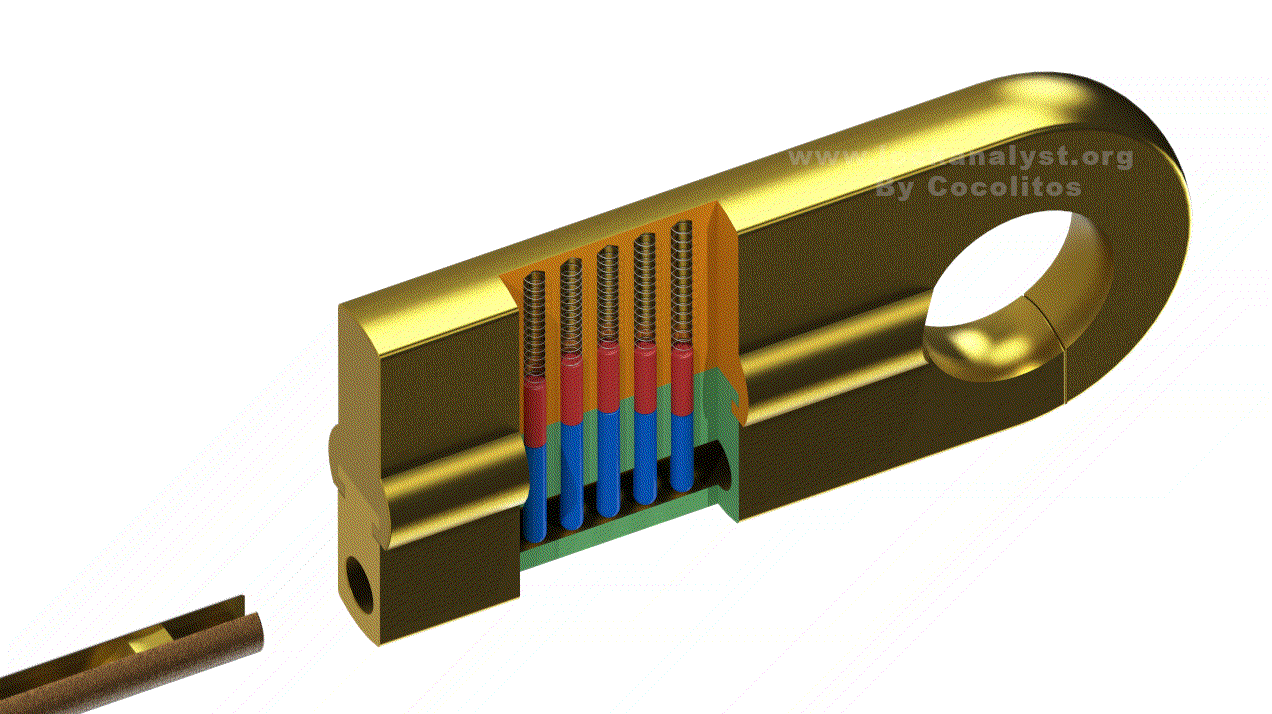
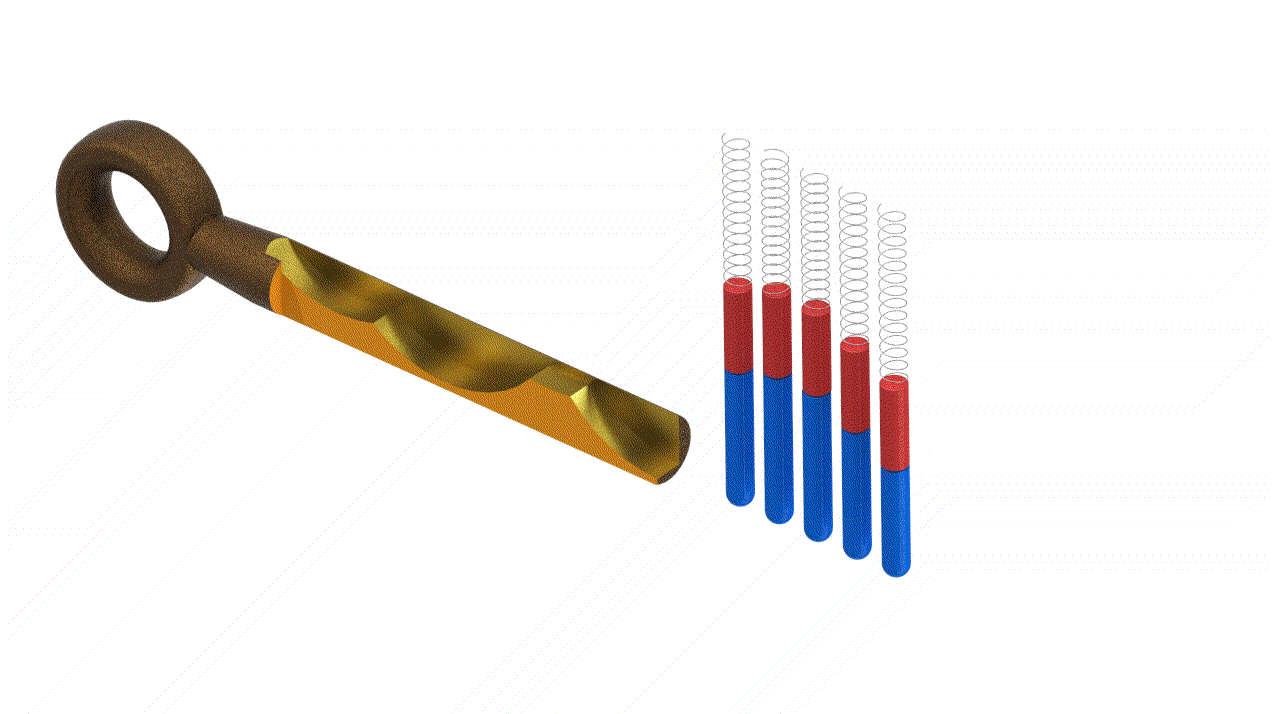
Cocolitos
[1] “The Rev. Abraham O. Stansbury and the Stansbury Press”, Philip J. Weimerskirch, Journal of the American Printing History Association, 2001, p 46-48.
[2] “Pantologia, a new cyclopaedia, comprehending a complete series of essays, treatises, and systems, alphabetically arranged; with a general dictionary of arts, sciences and words”, G. Kearsley, London, 1813.
[3] “Early Locks and Lockmakers of America”, Thomas F. Hennessy, Nickerson & Collins, Des Plaines, IL, 2nd edition, 1976, p 85.
[4] https://en.wikipedia.org/wiki/Yale-Cady_Octagon_House_and_Yale_Lock_Factory_Site
[5] “The cultivator, a monthly journal devoted to agriculture, horticulture, floriculture, and to domestic and rural economy”, C. Van Benthuysen, new series, volume 2, New York, 1845, p 318.
[6] “The Fifth Exhibition of the Massachusetts Charitable Mechanic Association at Faneuil and quincy halls, in the city of Boston”, Dutton and Wentworth, 1848, p 8.
[7] “The Sixth Exhibition of the Massachusetts Charitable Mechanic Association at Faneuil and quincy halls, in the city of Boston”,Kastburn’s press ,1850, p 21.
[8] “Report of the twenty-second Exhibition of American Manufacturers for the Promotion of the Mechanic Arts”, Franklin Institute of the State of Pennsylvania, 1852, p 5.
[9] US patent N°16,483 for “a machine for making coiled springs” by J. Harrison Jr.
[10] http://safelockcollector.com/safe-locks/picking-newells-parautoptic-lock/